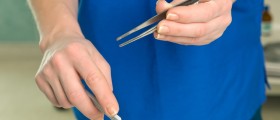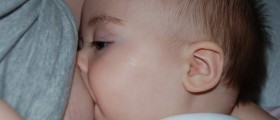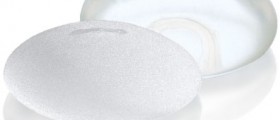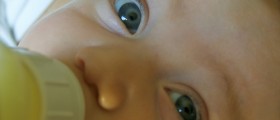Breast growth and development is very important for young girls and teenagers, and it seems that only a few of them are satisfied with their breasts. It is important to understand that breasts do not grow overnight and that their development occurs in stages, which go on for quite some time.
Stages of Breast Growth and Development
The first stage of breast development starts in early infancy. At first, the breasts are completely flat and there is no difference between a girl’s and a boy’s chest, but on closer observation a thin line of milk ducts can be noticed below the nipple. It is also possible to experience small discharge from this line only a few days after the birth.
The milk line is the termination point of milk ducts and it can be seen in both baby boys and baby girls. In boys, the line will disappear soon while in girls it will continue to develop as breasts and milk ducts develop.
In the second stage, between the infancy and the puberty, breasts show little or no visible development. Undeveloped breast tissue appears only as a mound of flesh around the nipple, but when the puberty sets in, the nipples and areolas appear raised and somewhat swollen. This is the first sign of incoming breast growth.
Each person enters the puberty at different age. Some girls start at the age of eight and others wait until they are 13. Throughout the puberty the breasts grow in size and they are clearly visible from the outside, but they are still far from the shape and form of adult breasts.
The fourth stage occurs at the passage between the puberty and the adulthood. These post-puberty changes occur in the late teen years and this is when the breasts become firmer, with more pronounced nipples and areolas. This stage indicates that the woman is ready for becoming sexually active and for becoming pregnant.
The final stage of breast development occurs during the first pregnancy and the lactation period. As the milk ducts grow and fill with milk, the breasts become larger, and during the nursing period the suction causes definitive changes on the nipples and the areolas.
- Prenatal breast development can be classified into two main processes; formation of a primary mammary bud and development of a rudimentary mammary gland. The earliest stages of embryogenesis are largely hormone independent; hormones and regulatory factors are important for development in the second trimester.
- As early as 4 to 6 weeks of gestation, mammary-specific progenitor cells may be seen. Around day 35 of gestation, proliferation of paired areas of epithelial cells in the epidermis of the thoracic region occurs. These discrete areas of proliferation extend in a line between the fetal axilla and inguinal region and form two ridges called the mammary crests or milk lines.
- By 6 months of gestational age, the basic framework of the gland is established. A well-defined tubular architecture in a bed of dense fibroconnective tissue stroma is noted at this stage. This is around the time breast tissue in both boys and girls can be apparent.
- Repeated branching of the secondary epithelial buds and canalization occur in the third trimester. Disagreement exists over the final morphology of the breast at birth. Although most sources agree these secondary processes end in rudimentary lobular structures or end buds, some argue that the breast at birth does not contain any evidence of lobules, only ductal structures with surrounding stroma.
- The first 2 years of life are a critical period for some aspects of breast maturation as well as involution. The normal gland remains quiescent from 2 years of age to puberty. At birth, the breast is usually palpable in the newborn with varying amounts of tissue and no significant difference between the genders. Falling levels of maternal estrogens in the neonate stimulate the neonatal pituitary gland to produce prolactin, which results in unilateral or bilateral breast enlargement and/or transient secretion of milk in as many as 70% of term neonates. It has been speculated that the infant breast undergoes stimulation at approximately 3 to 4 months postnatally through a surge of the infant's own reproductive hormones, including estradiol. Breast tissue in female infants persists longer than in male infants due to higher estradiol levels in infancy in girls.
- Sexually dimorphic development of the breast first begins at puberty and unlike the preceding stages of development, pubertal changes are heavily under the influence of sex hormones, in particular estrogen. Whereas the gross anatomic changes that occur at puberty are well described, events on an ultrastructural level are less well defined.
- Significant development of the nipple also occurs during puberty. The most marked increase in size and diameter of the nipple is seen between Tanner stages 3 and 5, particularly soon after menarche. The average increase in diameter between Tanner stages 1 to 5 is 5 to 6 mm. It is difficult to form measurable criteria of nipple diameter at each Tanner stage due to extensive variations found in increments of nipple size based on hormonal status, race, nutrition, and genetics.
Breast Enhancing Methods
Many women are not satisfied with their breasts and wish to make them bigger, firmer, shaped better, and so on. Some use herbs like fennel, kava-kava, saw palmetto, ginkgo biloba and similar. These herbs increase the hormonal levels, which results in breast growth.
Massage and chest exercise can also be effective. Massage stimulates circulation in the area, making the breasts firmer, and exercise aims to strengthen the muscles surrounding the breasts so they become more elevated, instead of sagging.
A good bra is very important for the shape of the breasts. It should support them, but gently, without pressing them. A bra that is too tight stifles the breasts, and a loose bra makes them saggy.


















Your thoughts on this
Loading...